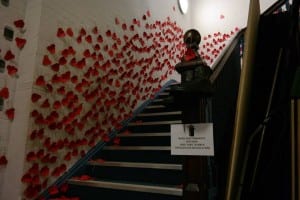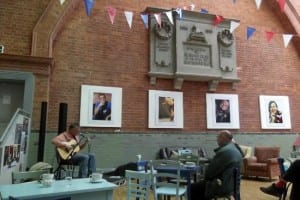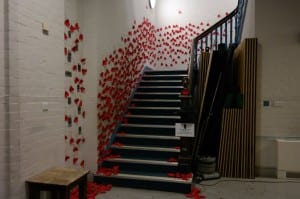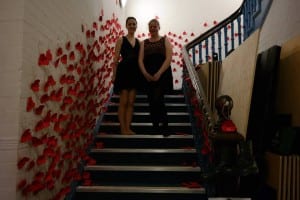Framing Statement
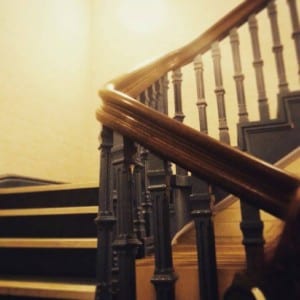
The Stairway to Heaven
Photo taken by Isabelle Harvey
Where and When?
Our performance took place at the Lincoln Drill Hall on the 9th of May, which is also known as Victory Day, the day in which World War II ended. This date actually ties in rather nicely with our piece as it is a military-based performance, however our piece focuses on World War I rather than World War II.
The main objective of our piece was to memorialise the soldiers of the 4th Battalion of Lincolnshire who tragically lost their lives during World War I. The relevancy of the site comes from the 4th battalion as this is the exact location they would have been shipped out from 100 years before.
Why?
As we mark the centenary of World War I, it is important to remember all of the men who lost their lives; it is every bit as relevant now as it was then. With our piece we aim to not only get the audience thinking about the history of the Drill Hall but we also intend to memorialise the soldiers in a respectful way.
What?
Our performance involved two performers (Kay Mosely and myself) hanging poppies on the back stairwell in the Drill Hall, while war poems and war-based music was played. Every time we hung a poppy we would recite the words written on the memorial plaque hanging in the café bar: “In memory of the glorious dead”. There were 1915 poppies hung on the wall, a symbol for the 100 years that have passed. 1915 is an especially important date with regards to the soldiers at the Drill Hall as tragically many of the soldiers in the 4th Battalion passed away at the “Battle of Loos (25 September – 13 October 1915)” (Lloyd, 2006, 346).
The audience were invited to hang their own poppies as an act of remembrance and respect. There was also a small performance at 5pm where we called out all of the names of the soldiers who died and held a two minute silence in which we could reflect on their time spent in the Drill Hall.
How Long?
As our piece was durational it lasted for a total of 3 hours with the final memorial at 5pm, lasting roughly 10 minutes. If possible we would have preferred our piece to have lasted longer so we could show proper respect and we wouldn’t have to rush putting the poppies up.
“In Flanders Field the Poppies Grow”
Photo Taken by Hope Papa
Analysis of Process
It’s very daunting to be given a site and to be told that you have to make a performance about it in a few months’ time, especially when Site Specific Performance is not something with which you are familiar with. The information given to us at the start was: “[Site Specific Performances] are inseparable from their sites, the only context within which they are readable…” (Pearson in Kaye, 1996, 211) This meant that if our performance could be taken from where we had it situated, then it wasn’t site specific.
We were told that we were not to perform as a character but to perform as ourselves, which would intimidate even the most egotistical of people! It was important for us to learn that there are many different types of performance and there were many different ways to tell stories. A vital part of our process was putting all of the knowledge we had about “what performance is” behind us and starting with a blank canvas.
Our first lesson spent drifting helped us do just this. Drifting allowed us to open our minds and see beyond our regular everyday spectrum and into something more interesting. We were able to really take note of what we were seeing and doing rather than just walking through life oblivious to our surroundings.
“In Memory of the Glorious Dead”
Image sourced from :http://www.tripadvisor.co.uk/Attraction_Review-g186336-d2697209-Reviews-Lincoln_Drill_Hall-Lincoln_Lincolnshire_England.html
Having said that we were to forget all of our previous knowledge on how performance works the given site at first seemed problematic. We were told that Site specific performances are not performances that you would see performed in theatres, but of course, these days, that is exactly what the Drill Hall is used for. It was important, for our process, to look beyond this box, if you will, and look into the rich and vibrant history of the Hall instead. A quote from Kaye in “Site Specific Art: Performance, Place and Documentation” actually perfectly sums up our piece:
“This is theatre and it is not theatre. This is an event in a theatre. This is not a theatre event – this is an act of remembrance.” (Kaye, 2008, 52)
On our first arrival at the Drill Hall, research in hand, Kay and I already knew that we wanted to do our work on the soldiers who had trained here. From my own perspective, the soldiers were an obvious choice as I grew up on an RAF airbase and was part of the Combined Cadet Force at my secondary school for a number of years. I felt a personal connection to these soldiers and I wanted the audience to feel a connection to. That was where the idea of audience participation came in. We were also keen for our piece to be one in which people could “pass-through” as we felt this action represented the soldiers who simply passed through life and through the Drill Hall before their untimely deaths.
“We wear the Poppies red in Honour of our Glorious Dead”
Photo taken by Hope Papa
The space in which we performed our piece may have seemed an odd choice as we chose the barely used back staircase, a “public place that [is] “hidden in plain sight” and visited by very few people” (Smith, 2010, 120). However not only did this allow for our idea of “passing-through”, but we were also fascinated by the idea of liminality in the space, both metaphorically and physically. When I say metaphorically I am referring to the liminality of the soldiers; they are in Limbo, on the threshold between life and death, not still here but not yet forgotten. The physical liminality refers to space itself. The staircase is an often overlooked area, we walk through it often but we never really take in our surroundings. Our time spent drifting taught us not to overlook anything and to really pay attention to your surroundings which is why, I believe, we were so engrossed with this particular site.
Our previous Site had been the balcony at the top of the stairs, which, if I am honest, we had chosen for shallow reasons and because that shallowness, we struggled to think of a good concept for our piece. On our way up to the balcony one day, we stopped on the stairs and all of a sudden everything fell into place. The air had this damp smell, like that of an army kit room, the lighting was dank and the walls completely bare. There was just something so aesthetically pleasing about the whole place. It was as though the site had found us, rather than the other way around.
Willi Dormer stated “I got to see a place which seemed to me empty, silent and uncared for – Willi Dorner 2005” (Pinchbeck, 2005) which was also what we saw. The peeling paint, the cracks on the walls, and the damp patches only added to the aesthetic. The stairs were uncared for, and were simply passed through on a day to day basis without much thought. It made me wonder how often the café bar was passed through without people noticing the memorial for the soldiers.
There was a certain stillness to the stairs when they were empty. What would happen if we took that emptiness and filled it? Would the dynamic of the space change? Willi Dormer did just that in his 2009 piece Bodies in Urban Spaces. He used a group of dancers who “jammed into crevices curled round lampposts, plastered themselves against buildings, holding each unlikely pose for only a few minutes.” (Jays, 2009, 53) This changed the dynamic of those spaces as before they had been unnoticed but now people off the street were stopping to notice the difference in the space. We thought that it would be interesting to try this ourselves; to see whether we could change the space from a simple staircase into an area for memorialisation of those soldiers.
We decided to use poppies to fill the space, as poppies are the symbol of remembrance and of the bloodshed in the war. We were influenced by a piece entitled “Blood Swept Lands and Seas of Red” by artists Paul Cummins and Tom Piper, that took place at the Tower of London in October of 2014. The idea behind their piece was that each poppy represented a British soldier who had died during the First World War.
“Blood Swept Lands and Seas of Red”
Image sourced from: https://speedingdragon.wordpress.com/2014/08/04/blood-swept-lands-and-seas-of-red/
We also found influence in Stan’s Café’s performance: Of all the People in all if the World. The piece “uses grains of rice to bring formally abstract statistics to startling and powerful life. Each grain of rice = one person” (Stan’s Café, 2006). The sheer number of the grains of rice are what shocked people and make them aware of the sheer quantity of deaths during the holocaust. We had originally hoped that we could create enough poppies for each one to mark a Lincolnshire soldier’s death, however we discovered that due to time constraints this would be impossible as this figure was over 8,000. Conversely, we discussed using poppies for each of the men who had trained at the Drill Hall but found that this would have little impression on an audience as the number was too small for such a large space. Instead we decided to use the number 1915 to symbolise the passing of 100 years.
The poppies that we made were purposely stored flat and during our performance we would open out the petals which created a symbolic message: The poppies seemed as if they were dead until we opened up their delicate petals and gave them life, this was symbolic of the “life” we were giving the soldiers by holding this performance in their memory. We made photographs of the soldiers available, which were hung among these poppies so that the audience were made aware that these were all real people. I think it’s easy to forget, sometimes, that these were real people who died to protect others.
We made a soundscape to go with our piece so that we could make sure that tie between the poppies and the soldiers was obvious. The soundscape included poems written by soldiers at the time of World War I (all of which revolved around the themes of poppies and death) and songs written by people in memorial of those who had died while at war. It was also nice to add a narrative as it created a new depth to the piece. It also allowed the audience to really understand the meaning of the piece.
“Age Shall not Weary Them, nor the Years Condemn”
Photo Taken by Hope Papa
We also used blocks of two minutes of silence, in which Kay and I would stand completely still with our heads bowed in an act of remembrance. It allowed us to pay homage to all the soldiers privately, which I think was important to both Kay and I as we had both developed quite an emotional attachment to the soldiers during our time spend researching them for this piece. This was also done for practical reason (as climbing the stairs constantly for 3 hours is tiring!) but similarly because it allowed us to bring back some of that stillness that the site had offered us before.
The small performance was done at the end was not only so the audiences could have an opportunity to remember the soldiers who died, but also as an opportunity for us to show our thanks to them. As mentioned before, both Kay and I felt a real connection to the piece and by reading the names at the end, it allowed us to surreptitiously thank them.
During the name reading a poppy was dropped for each name spoken, signifying their fall in the battle. This was not a planned part of our piece, we decided just before that we wanted something symbolic for the audience to watch as we read the names so it would really hit home to them that these men died in very tragic ways. The poppies fell quite heavily due to their weight and the noise that they made as they hit the floor certainly created quite an emotional impact on several of the audience members and ourselves. After the names were read we engaged in a two minute silence with the audience which allowed a connection between us all: audience, performers, and soldiers. The soldiers brought us all together in one act of remembrance, creating a still and silent, yet highly emotional group dynamic. There was absolutely no sound from anywhere which brought us back into that same stillness that had drawn us to the site in the first place. We had completed the full circle.
“At the Going Down of the Sun and in the Morning
We Will Remember Them”
Photo Taken by Hope Papa
Performance Analysis
It was difficult to gauge how many the number of audience members that visited our piece as it was designed to be walked through and many audience members returned throughout the duration of the piece to see how the space had changed. However, all the audience members we did have, engaged themselves with our piece in one way or another, whether that be through videoing or photographing the piece, hanging their own poppies, or simply spectating. We were welcomed by a pleasant surprise from many of the audience members when they saw how we had transformed the space with our poppies showing that we had made an impact on them and we were even invited to keep our installation up in the Drill Hall so we have the potential to reach an even larger audience.
Strengths
The audience participation certainly worked better than we had hoped, as almost every audience member hung at least one poppy of their own. In my opinion, this allowed the audience to feel a connection to the soldiers and the Drill Hall as they were as much part of the piece as we were.
During our piece I felt very connected to our site and felt very present, perhaps this was due to the focus that we held during our piece or the audience members that were participating alongside us. It gave our piece a new personal meaning to both Kay and I; a sense of closure, perhaps. We had spent the entire semester learning about these soldiers and our performance felt as though we were laying them to rest all over again after digging up their past. This particular feeling was fairly emotional to us as we were very aware of the sheer number of soldiers who were put to rest in unmarked graves.
Weaknesses and Improvements
If we could do this same performance again, I would like a longer duration in which to do it, as, due to the sheer magnitude of poppies, we had to rush putting them up towards the end which, I felt took away from the tranquil ambience of the piece. It would also be beneficial to record a new audio or to play around with the idea of live sound. This felt a little unfeasible this time around though as there were only two of us performing; if we had a larger number of performers this may have been possible.
Due to the number of other Site groups working that day and the noise of the traffic outside, we had a little trouble setting the exact aesthetic we were looking for as there were many distractions for the audience. This would be improved by shutting the doors nearest the round and closing any doors between our performance and others. This would have helped create a stillness and a timelessness that we felt our piece needed to be complete.
Bibliography
Jays, D. (2009) Dance Umbrella 2009. Dancing Times, 100 (1192).
Kaye, N. (2008) Site Specific Art: Performance, Place and Documentation. Routledge: London
Lloyd, N. (2005) Lord Kitchener and ‘the Russian News’: Reconsidering the Origins of the Battle of Loos. Defence Studies. 5 (3) 346.
Pinchbeck, M (2005), Nottdance 2005 Toolkit. Dance 4: Nottingham
Smith, P. (2010) Mythogeography: A Guide to Walking Sideways. Axminster: Triarchy Press.
Source: Kaye, N. (2008) Site Specific Art: Performance, Place and Documentation. Routledge: London
Stan’s Café (2006) Stan’s Café Theatre Company. [online] Available from http://www.stanscafe.co.uk/project-of-all-the-people.html [Accessed 11/05/15]

